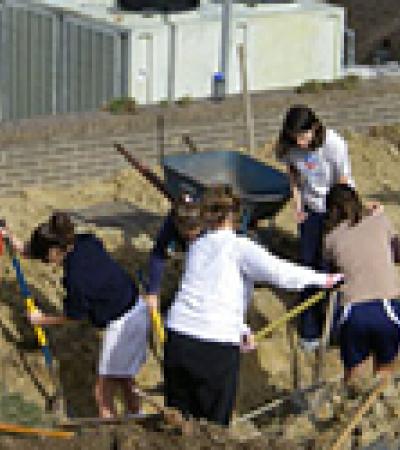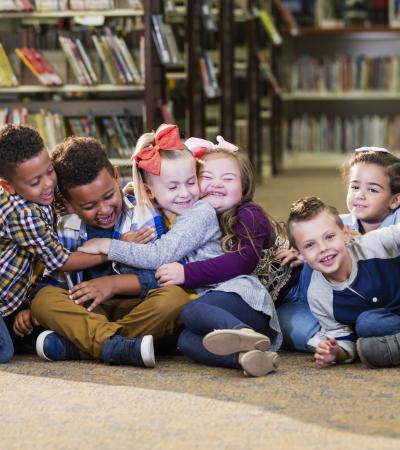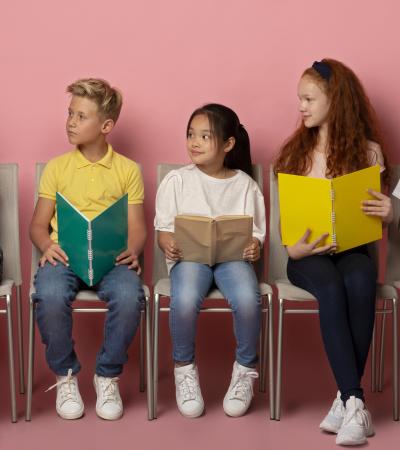Spalding/Sign Language is a year-long humanities program for kindergarteners. Our goal is to inspire a love of reading and offer a distinctly different idea for teaching literacy from the classroom. We have been able to do this by teaching letter sounds using the phonetic Spalding method and American Sign Language (ASL).
Sign language is a fabulous way to communicate. For those students who need alternate ways to communicate in front of others, it is the perfect solution. Even those students who don’t have any inhibitions love learning to speak in sign language.
Collaboration with the kindergarten teachers is vital to the success of this library program. We coordinate the introduction of each letter and letter sound with what is being introduced and taught in the classroom; that way the library can be a resounding support of the phonics that are being taught by the classroom teacher. This also provides each student with a multitude of ways to learn the sounds, letters and the language of signing.
Advanced Planning
There are approximately 135 students that attend kindergarten or preschool and are involved in the sign language program. Learning another language promotes higher order thinking skills, e.g. analyzing, applying, creating and so on. These need to be emphasized in teaching and learning a foreign language because it is a skill learning, which is much more than knowledge transfer. Skill learning requires thinking and creativity to apply what you learned.
By learning a new language, you gain a better understanding of your own language. Additional benefits of learning sign language include terminology; dominant and nondominant hands; motor skills; spoken and sign language development; literacy; vocabulary building; and creating connections between words, phrases and ideas. It forces you to remember visual sequences when looking at new words or reviewing flashcards.
Marketing
Collaborating with the kindergarten teachers, I promoted this program throughout the school year. As the students progressed and were able to see/feel their progress, we began to speak about their end-of-the-year program and how they would shock the community's socks off be speaking/singing in another language. Students love to learn, and when you present them with a challenge that is exciting, they swarm to you with a passion like your own.
Budgeting
There is no cost to present this program except for the Spalding cards. However, those can be hand-made at no cost if necessary.
A benefit and cost would be to attend more classes on learning to sign as the program instructor.
Day-of-event Activity
The program needs very minimal set-up each day. The only staffing requirements were handled by the librarian and library clerical. The culmination of the program finale was the kindergarten graduation program at a local auditorium with an audience of parents, grandparents, extended family members, bus drivers, kindergarten teachers, auditorium staff, community members, etc.
This program takes a village of staff members to pull off; however, there were no unexpected challenges, and the students did indeed knock the community's socks off with their presentation of singing an entire song in sign language!
Program Execution
This program was born from observing kindergartners and students with special needs who were shy, withdrawn and apprehensive to boldly speak their sounds and letters. Reaching out of the box to ensure covering the foundational skills through the district, state and national standards was an interesting quest.
At the beginning of the year, we begin one letter at a time, introducing the letter and the sound using a method called Spalding. I was trained in Spalding years ago when I was teaching kindergarten at another school in the district. This method is similar to Saxon phonics and some other phonics programs.
Let’s take the letter A to begin. The letter A is shown to the students visually on a card. I then say all the sounds (3) that the letter A makes using my fingers as a guide for each sound. The students repeat all 3 sounds. After we practice the sounds, I introduce the “sign” for letter A. I explain to the students that sign language is another way to communicate with others — that some can’t use their voice boxes to make sound, so in order to communicate there is a language called sign language. Fingerspelling is how we learn the individual letters such as A, B and C.
This type of learning could be used in small groups, whole groups or independently. Modification of the program of teaching a foreign language, such as sign language, would depend on the educator’s flexibility as it relates to time, class size, attention span and personal knowledge and training of sign language.
Reactions from the students has probably been the most rewarding. To see the gleam in a child’s eyes when they “get it” is the intangible reward of being an educator. Giving them the opportunity to learn sign language has helped them develop their empathy toward others who may or may not learn in the exact same way as they do.
These students have owned this new language and are sharing it in the community. From grocery stores, ball fields, dance studios, karate studios and day cares, these little learners have shared their knowledge of sign language.
Advice
Changes in the program for me would have to include more self-knowledge of sign language. On the ALA website that there is a six-week eCourse available called “Sign Language for Children in Storytime or in the Classroom: A Practical Guide eCourse.” This could help me and other librarians have more of an impact as an educator and especially as a teacher of kindergartners.



